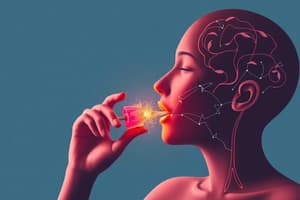Podcast
Questions and Answers
Where are special sense receptors primarily located?
Where are special sense receptors primarily located?
- In the spinal cord
- Throughout the body
- Within complex sense organs in the head (correct)
- Distributed evenly under the skin
Which of the following is an example of a general sense?
Which of the following is an example of a general sense?
- Vision
- Smell
- Touch (correct)
- Taste
Which two senses are considered chemical senses?
Which two senses are considered chemical senses?
- Hearing and balance
- Vision and hearing
- Smell and taste (correct)
- Touch and vision
How do chemoreceptors detect chemicals?
How do chemoreceptors detect chemicals?
Where is the olfactory cortex located?
Where is the olfactory cortex located?
What type of cells are the receptors for gustation?
What type of cells are the receptors for gustation?
What extends from the tip of gustatory cells through a taste pore?
What extends from the tip of gustatory cells through a taste pore?
Which of the following is NOT one of the five basic taste sensations?
Which of the following is NOT one of the five basic taste sensations?
The sensation of 'umami' is associated with which of the following?
The sensation of 'umami' is associated with which of the following?
Which of the following is an accessory structure of the eye?
Which of the following is an accessory structure of the eye?
Which structure is the transparent coat that covers the colored iris?
Which structure is the transparent coat that covers the colored iris?
What is the function of the lacrimal glands?
What is the function of the lacrimal glands?
Which muscle elevates the upper eyelid?
Which muscle elevates the upper eyelid?
Which of the following moves the eye inward (adduction)?
Which of the following moves the eye inward (adduction)?
What is the result of macular degeneration?
What is the result of macular degeneration?
Which area of the retina has the highest concentration of cones and visual acuity?
Which area of the retina has the highest concentration of cones and visual acuity?
What happens to the pupil in bright light?
What happens to the pupil in bright light?
Where are the receptors for vision located?
Where are the receptors for vision located?
Which type of visual receptor is responsible for color vision?
Which type of visual receptor is responsible for color vision?
What process involves the bending of light rays?
What process involves the bending of light rays?
Which type of lens converges light rays?
Which type of lens converges light rays?
What is accommodation in the context of vision?
What is accommodation in the context of vision?
What is the blind spot in the eye also known as?
What is the blind spot in the eye also known as?
Which of the following is contained by the posterior segment of the eyeball?
Which of the following is contained by the posterior segment of the eyeball?
Which structure produces meibum, an oily substance that prevents evaporation of the eye's tear film?
Which structure produces meibum, an oily substance that prevents evaporation of the eye's tear film?
Which tunic is the inner layer of the posterior eye?
Which tunic is the inner layer of the posterior eye?
The sclera is part of which tunic?
The sclera is part of which tunic?
Which is NOT an interchangeable term for optic disc?
Which is NOT an interchangeable term for optic disc?
Flashcards
General Senses
General Senses
Sensory receptors found throughout the body, detecting tactile, temperature, and pain sensations.
Special Senses
Special Senses
Sensory receptors located within complex sense organs in the head, including vision, smell, taste, hearing, and equilibrium.
Two Chemical Senses
Two Chemical Senses
Olfaction (smell) and gustation (taste).
Chemoreceptors
Chemoreceptors
Signup and view all the flashcards
Olfactory Cortex Location
Olfactory Cortex Location
Signup and view all the flashcards
Gustatory Cells
Gustatory Cells
Signup and view all the flashcards
Five Basic Taste Sensations
Five Basic Taste Sensations
Signup and view all the flashcards
Taste Detection
Taste Detection
Signup and view all the flashcards
Gustatory cortex
Gustatory cortex
Signup and view all the flashcards
Accessory Structures of the Eye
Accessory Structures of the Eye
Signup and view all the flashcards
Three Tunics of the Eye
Three Tunics of the Eye
Signup and view all the flashcards
Cornea
Cornea
Signup and view all the flashcards
Optic Disc (Blind Spot)
Optic Disc (Blind Spot)
Signup and view all the flashcards
Sclera
Sclera
Signup and view all the flashcards
Tarsal Glands
Tarsal Glands
Signup and view all the flashcards
Lacrimal Glands Function
Lacrimal Glands Function
Signup and view all the flashcards
Extraocular Muscles
Extraocular Muscles
Signup and view all the flashcards
Macula Lutea
Macula Lutea
Signup and view all the flashcards
Macular Degeneration
Macular Degeneration
Signup and view all the flashcards
Fovea Centralis
Fovea Centralis
Signup and view all the flashcards
Pupil response
Pupil response
Signup and view all the flashcards
Visual Receptors Location
Visual Receptors Location
Signup and view all the flashcards
Eye detects light
Eye detects light
Signup and view all the flashcards
Refraction
Refraction
Signup and view all the flashcards
Convex
Convex
Signup and view all the flashcards
Concave
Concave
Signup and view all the flashcards
Accommodation
Accommodation
Signup and view all the flashcards
Study Notes
- Study notes for the special senses
General vs. Special Senses
- General sensory receptors are widely distributed throughout the body and handle tactile, temperature, and pain sensations.
- Special sensory receptors are located in complex sense organs in the head, dealing with vision, smell, taste, hearing, and equilibrium.
Chemical Senses
- Olfaction (smell) and gustation (taste) are the two chemical senses.
- Chemoreceptors are the receptors for these senses and detect chemicals dissolved in aqueous solutions.
- Airborne chemicals are dissolved in nasal membranes for smell.
- Food chemicals are dissolved in saliva for taste.
Olfaction (Smell)
- Odors are detected by chemoreceptors in the nasal cavity.
- Olfactory impulses are sent along olfactory tracts to the olfactory cortex located in the temporal lobe.
Gustation (Taste)
- Gustatory cells, basal cells, and supporting cells comprise taste receptors.
- Gustatory cells are taste receptor cells, with microvilli extending through a taste pore.
- Basal cells are stem cells that give rise to new gustatory cells every 10 days.
- Supporting cells provide structural support to the gustatory cells but are not involved in taste sensation.
Basic Taste Sensations
- The five basic taste sensations are:
- Sweet: sugars, alcohol, saccharin
- Sour: acids (hydrogen ions in solution)
- Salty: metal ions; sodium chloride tastes "saltiest"
- Bitter: alkaloids such as nicotine, caffeine, and nonalkaloids such as aspirin
- Umami: amino acids glutamate and aspartate, characteristic of "beef" taste and found in MSG and aging cheese
Taste Detection and Processing
- A tastant must dissolve in saliva, diffuse into a taste pore, and contact microvilli to be detected.
- Impulses are sent to the gustatory cortex in the parietal lobe and the limbic system.
- These regions determine our appreciation of what we are tasting.
Gustatory Cortex
- The gustatory cortex is located in the insular cortex and the frontal operculum of the brain.
Structures of the Eye and Their Functions
- Accessory structures protect and aid eye function and include:
- Eyebrows
- Eyelids
- Conjunctiva
- Lacrimal apparatus
- Extrinsic eye muscles
- The wall of the eyeball has three tunics:
- Fibrous tunic(outer layer): sclera, cornea
- Vascular tunic(middle layer): choroid, ciliary body, iris
- Nervous tunic layer(inner layer): retina
Key Structures to Identify and Label
- Retina
- Choroid
- Ciliary body
- Cornea
- Iris
- Optic nerve
- Optic disc (blind spot)
- Pupil
- Lens
- Anterior cavity
- Sclera
- Posterior cavity
- Eyelids
- Eyebrows
- Eyelashes
- Conjunctiva
- Lacrimal caruncle
- Lacrimal gland
- Tarsal glands
- Ciliary processes
- Ciliary muscles
- Ciliary zonule
- Posterior segment (vitreous humor)
- Anterior segment (aqueous humor)
- Extrinsic eye muscles
Additional Information on Structures
- Tarsal glands produce meibum, preventing evaporation of the eye's tear film.
- Lacrimal glands continuously produce and secrete tears that drain, cleaning, nourishing, and lubricating the eye's surface and are located on the lateral side of the orbit.
Extraocular Muscles
- Levator palpebrae superioris: Elevates the upper eyelid
- Superior rectus: Moves the eye upward
- Inferior rectus: Moves the eye downward
- Medial rectus: Moves the eye inward (adduction)
- Lateral rectus: Moves the eye outward (abduction)
- Superior oblique: Rotates the eye inward and downward
- Inferior oblique: Rotates the eye outward and upward
Macula Lutea
- The macula lutea is the center of the posterior portion of the retina and the visual axis of the eye.
- Macular degeneration causes damage to the macula, leading to loss of central vision but retention of peripheral vision.
Fovea Centralis
- The fovea centralis is a depression in the center of the macula lutea, containing the highest concentration of cones.
- The fovea centralis is the area of highest visual acuity.
Autonomic Nervous System Regulation of Pupil Diameter
- Bright light and close vision:
- Circular muscles (pupillary constrictor muscles) contract, causing the pupil to constrict.
- Dim light and distant vision:
- Radial muscles (pupillary dilator muscles) contract, causing the pupil to dilate.
Receptors for Vision
- The receptors for vision, rods and cones, are located in the retina.
- Rods are highly sensitive to light and crucial for peripheral and low-light vision (scotopic vision).
- Cones are responsible for color vision and high visual acuity (photopic vision) in bright light conditions.
Eye Detection of Light and Visual Pathway
- Photoreceptor cells (rods and cones) in the retina convert light into electrical signals.
- The electrical signals travel through the optic nerve to the brain for processing.
Refraction in Image Formation
- Refraction is the bending of light rays caused by a change in the speed of light as it passes from one transparent medium to another at an oblique angle.
- Lenses refract light because they are curved on both sides.
Convex Lenses
- Convex lenses are thicker in the center than at the edges and converge light rays.
- The image formed by a convex lens is inverted, upside down, and reversed from left to right.
Concave Lenses
- Concave lenses are thicker at the edges than in the center and diverge light rays.
- Concave lenses prevent light from focusing.
Accommodation
- The lens can adjust its curvature to allow for fine focusing.
Studying That Suits You
Use AI to generate personalized quizzes and flashcards to suit your learning preferences.




